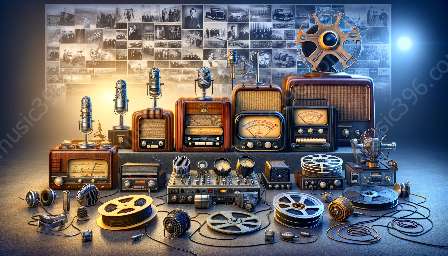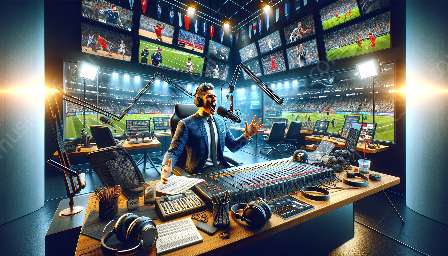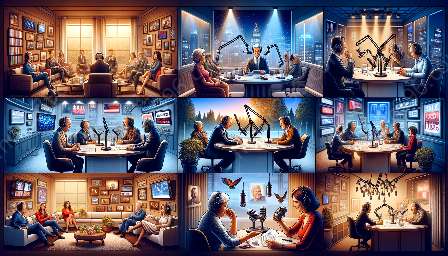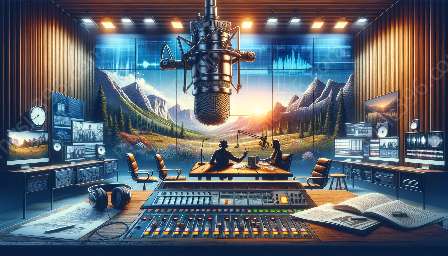Sportscasting in radio is a dynamic and captivating form of audio content creation that brings the excitement of sports to the airwaves. In this article, we will delve into the world of sportscasting in radio, exploring its history, the skills required, and how it intersects with music and audio.
The History of Sportscasting in Radio
Sportscasting in radio has a rich history that dates back to the early 1920s when live sports events were first broadcast on the radio. Legendary broadcasters such as Graham McNamee and Bill Stern paved the way, bringing the thrill of sports to listeners across the country. As technology advanced, radio became the go-to medium for sports coverage, with iconic moments like the "The Miracle on Ice" at the 1980 Winter Olympics capturing the imagination of audiences.
Skills Required for Sportscasting in Radio
Successful sportscasters possess a unique set of skills that set them apart in the competitive world of radio broadcasting. Not only do they need in-depth knowledge of various sports, but they also need to have strong communication skills, the ability to think on their feet, and a knack for storytelling. Additionally, a deep understanding of radio production and sound engineering is essential to deliver a seamless and immersive listening experience.
The Intersection of Sportscasting and Music/Audio
Sportscasting and music/audio go hand in hand, creating a multisensory experience for listeners. The use of music in radio sportscasting adds drama, excitement, and emotion to the broadcast, enhancing the overall storytelling. Additionally, sound effects and ambient audio create a vibrant atmosphere, putting the audience right in the heart of the action, whether it's the roar of a crowd or the thud of a basketball hitting the court.
The Evolution of Sportscasting in Radio
With the rise of digital radio and streaming platforms, sportscasting has evolved to reach a global audience. Today, sports radio shows feature interactive elements, allowing listeners to call in, participate in polls, and engage with the broadcasters in real time. This interactive approach has transformed the traditional radio sports broadcast into a community-driven experience, where fans can connect with each other and with the broadcasters.
Conclusion
As technology continues to advance, the future of sportscasting in radio looks incredibly bright. The marriage of sports and sound in the radio medium creates an unmatched platform for delivering thrilling sports content to audiences around the world.
In conclusion, sportscasting in radio is an art form that combines the best of sports and audio to create an engaging and immersive experience for listeners. Whether it's the play-by-play commentary, in-depth analysis, or the emotional highs and lows of sports, sportscasting in radio continues to captivate audiences and define the intersection of sports and audio entertainment.
Topic
History and evolution of sportscasting on radio
View details
Legal and ethical considerations for radio sportscasters
View details
Engaging with listeners and building a loyal audience on radio
View details
The impact of technology and social media on radio sportscasting
View details
Psychological and emotional aspects of radio sportscasting
View details
Techniques for immersive and compelling sports commentary on radio
View details
Role of analysis and commentary in radio sportscasting
View details
Cultural considerations in international sports radio broadcasting
View details
Challenges and strategies for live event sportscasting on radio
View details
The future of sportscasting and radio broadcasting
View details
Integration of advertisements and sponsorships in sports radio broadcasts
View details
Creating a personal brand and online presence as a radio sportscaster
View details
Building rapport and conducting interviews with athletes on radio
View details
Creating a sense of community and interaction in sports radio broadcasting
View details
Key skills for a successful career in radio sportscasting
View details
Catering to diverse audiences in sports radio broadcasting
View details
Play-by-play commentary and live event coverage on radio
View details
Building professionalism and unbiased reporting in sports radio broadcasts
View details
Pre-game and post-game shows in radio sportscasting
View details
Utilizing sound effects and immersive elements in sports radio broadcasts
View details
Creating a balance between informative content and entertainment in sportscasting
View details
The impact of play-by-play commentary on radio sporting events
View details
Creative techniques for engaging with the audience during live radio broadcasts
View details
Utilizing data and statistics for enhanced sports commentary on radio
View details
Capturing the emotion and excitement of live sports events on radio
View details
Psychological and emotional elements in pplay-by-play commentary on radio
View details
Building a compelling and loyal audience for sports radio broadcasting
View details
Incorporating feedback and interaction from listeners in sports radio broadcasts
View details
Prominent career paths and opportunities in radio sportscasting
View details
Strategies for maintaining accurate and timely updates during live radio sports broadcasts
View details
The role of color commentary and storytelling in radio sportscasting
View details
Questions
What are the key skills required for a successful career in sportscasting?
View details
How has technology and social media impacted sportscasting in radio?
View details
What are the ethical considerations for sportscasters when reporting on sensitive sports topics?
View details
How can sportscasters effectively engage with their audience on radio?
View details
What role does play-by-play commentary play in enhancing the radio broadcast of sporting events?
View details
How has the evolution of sports broadcasting influenced the role of sportscasters on radio?
View details
What are the key differences between radio and television sportscasting?
View details
What are the challenges and opportunities of sportscasting live events on radio?
View details
How can sportscasters utilize sound effects to enhance the radio broadcasts of sports events?
View details
What are the best practices for conducting interviews with athletes and coaches on radio?
View details
What are the legal implications of broadcasting sporting events on radio?
View details
How does sportscasting contribute to the overall fan experience of a sports event on radio?
View details
What are the psychological aspects to consider when delivering sportscasting on radio?
View details
How does color commentary contribute to the storytelling aspect of sportscasting on radio?
View details
What are the cultural considerations in sportscasting for international sporting events on radio?
View details
What are the potential career paths for individuals interested in pursuing sportscasting in radio?
View details
How can sportscasters effectively capture the emotion and excitement of live sports events on radio?
View details
How do radio sportscasters engage with their listeners and build a loyal audience?
View details
What are the challenges and strategies for providing accurate and timely updates during live radio broadcasts of sports events?
View details
What role does analysis and commentary play in captivating the audience during radio sportscasting?
View details
How can radio sportscasters cater to diverse audiences and varying levels of sports knowledge?
View details
What are the key components of effective pre-game and post-game shows in sportscasting on radio?
View details
How can sportscasters maintain professionalism and unbiased reporting in radio sports broadcasting?
View details
What are the trends and innovations shaping the future of sportscasting in radio?
View details
How do sportscasters balance between providing informative content and entertaining the audience during radio broadcasts?
View details
What are the techniques for creating compelling and immersive storytelling in sports radio broadcasts?
View details
How do sportscasters create a sense of community and camaraderie among their radio audience?
View details
What are the strategies for incorporating listener feedback and interaction during sports radio broadcasts?
View details
How do sportscasters build rapport with athletes and other key figures in the sports industry for interviews on radio?
View details
What are the considerations for integrating advertisements and sponsorships into sports radio broadcasts?
View details
How do radio sportscasters adapt to unexpected or sudden changes during live sports broadcasts?
View details
What are the stylistic elements that set radio sportscasting apart from other forms of sports media?
View details
How can sportscasters create a strong personal brand and online presence to complement their radio work?
View details









































